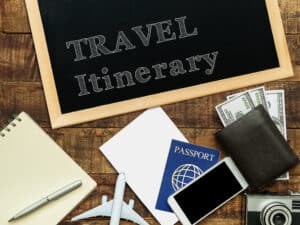Escape to Europe: How to Turn Your Travel Dreams into Reality
Does the thought of cobblestone streets, ancient ruins, and vibrant cafes make your heart race?
Europe awaits, promising a whirlwind of culture, history, and unforgettable experiences.
Let’s turn your travel fantasies into reality!
In this guide, I’ll share the secrets to planning a European getaway that seamlessly blends excitement and ease.
Benefits of traveling to Europe
There are numerous benefits to traveling to Europe. First, Europe is home to some of the world’s most iconic landmarks and attractions.
From the Eiffel Tower in Paris to the Colosseum in Rome, there is no shortage of must-visit destinations.
Additionally, Europe is known for its rich history and cultural heritage. Exploring ancient ruins, medieval castles, and Renaissance art is like stepping back in time.
Another benefit of traveling to Europe is the diversity of experiences. Each country has its own unique charm and character.
You can go from sipping wine in the vineyards of Tuscany to skiing in the Swiss Alps in just a few hours. The variety of cuisines, languages, and landscapes is truly incredible.
Best time to visit Europe
Choosing the best time to visit Europe depends on your preferences and the activities you have in mind.
The summer months of June, July, and August are the most popular, as the weather is warm and most attractions are open.
However, this also means larger crowds and higher prices. If you prefer to avoid the crowds, consider visiting in the shoulder seasons of spring (April to May) and fall (September to October).
The weather is still pleasant, and you’ll have a more authentic experience.
If you’re a winter lover, Europe offers magical experiences during the colder months. You can visit Christmas markets, go skiing, or enjoy cozy evenings by the fireplace.
Just be prepared for colder temperatures and shorter daylight hours.
Essential travel documents for Europe
Before you embark on your European adventure, make sure you have all the necessary travel documents.
The most important document is your passport. Ensure that it is valid for at least six months beyond your planned departure date.
Some countries in Europe also require a visa for entry, so check the entry requirements for each country you plan to visit.
It is also advisable to have travel insurance that covers medical expenses and trip cancellation.
While Europe generally has excellent healthcare systems, accidents and illnesses can happen, and the cost of medical treatment can be high.
Planning your Europe itinerary
Planning your Europe itinerary can be overwhelming, given the number of countries and attractions to choose from.
Start by identifying your top priorities and interests. Do you want to explore cities, visit historical sites, relax on the beach, or immerse yourself in nature?
Next, consider the duration of your trip and the time you have available.
Europe offers a wealth of options, so it’s essential to prioritize and allocate enough time for each destination. Remember to factor in travel time between cities and countries.
Research is key when planning your itinerary. Use travel guides, online resources, and recommendations from fellow travelers to gather information about each destination.
Consider the best time to visit, must-see attractions, and local customs or traditions.
These are some of my favorite booking resources.
Finding affordable flights to Europe
Finding affordable flights to Europe is essential to make the most of your travel budget. Here are a few tips to help you find the best deals:
Be flexible with your travel dates and consider flying on weekdays, as weekends tend to be more expensive.
Use flight comparison websites and sign up for price alerts to track fares and get notified of any price drops.
Consider booking a multi-city itinerary instead of a round-trip ticket. This allows you to fly into one city and out of another, saving time and money on transportation.
Look for budget airlines that offer discounted fares within Europe. Just be mindful of additional fees for baggage and other services.
Consider alternative airports near your destination. Sometimes flying into a smaller airport can be more cost-effective.
These are some of my favorite flight booking resources for booking inexpensive International flights.
Accommodation options in Europe
Europe offers a wide range of accommodation options to suit every budget and preference. Here are some popular choices:
Hotels: From luxury resorts to budget-friendly options, hotels are a convenient and comfortable choice. Look for deals or discounts, especially during the offseason.
Booking.com is a great website for booking hotels.
Hostels: Ideal for budget travelers or those looking to meet fellow backpackers, hostels offer affordable dormitory-style accommodations.
Vacation rentals: Platforms like Airbnb and HomeAway provide a wide range of apartments, houses, and villas for short-term rentals. This option is great for families or larger groups.
Bed and Breakfasts: For a more personalized experience, consider staying in a bed and breakfast. These charming establishments often include breakfast in the room rate.
Camping: If you enjoy the outdoors, camping is a great option. Europe has numerous campsites with facilities and beautiful natural surroundings.
These are a few of my favorite resources for booking hotels and places to stay while traveling in Europe.
Transportation within Europe
Getting around Europe is relatively easy, thanks to its extensive transportation network. Here are the main modes of transportation to consider:
Trains: Europe has an excellent rail system, connecting major cities and even smaller towns.
Trains are fast, efficient, and offer scenic views along the way. Consider purchasing a Eurail pass for unlimited travel within a specific period.
Buses: Buses are a budget-friendly option for traveling between cities and countries. Companies like FlixBus and Eurolines offer comfortable buses with various amenities.
Flights: If you’re short on time or need to cover long distances, flying within Europe can be a time-saving option. Budget airlines like Ryanair and EasyJet offer affordable fares.
Rental cars: Renting a car allows you to explore remote areas and have more flexibility.
However, keep in mind that parking can be expensive in cities, and some countries have toll roads or driving restrictions.
Public transportation: Most European cities have efficient public transportation systems, including metros, buses, and trams. Invest in a city travel card or pass for unlimited travel within a specific period.
Safety tips for traveling in Europe
Europe is generally a safe destination for travelers, but it’s always wise to take precautions. Here are some safety tips to keep in mind:
Be aware of your surroundings and keep an eye on your belongings, especially in crowded tourist areas.
Avoid displaying valuable items or large amounts of cash in public. Use a money belt or a secure travel wallet to keep your money and documents safe.
Research the local customs and laws of each country you visit to avoid any unintentional offenses or misunderstandings.
Stay informed about current events and potential safety risks. Check travel advisories and register with your embassy or consulate before traveling.
Use reputable transportation services and licensed taxis. If you’re using public transportation, be cautious of pickpockets and keep your belongings secure.
My favorite travel insurance company is Safety Wing.
Europe travel hacks and insider tips
To make your Europe travel experience even more enjoyable, here are some insider tips and travel hacks:
Pack light: Europe is known for its cobblestone streets and narrow staircases. Opt for a carry-on suitcase or a backpack to make navigating easier.
Learn basic phrases: While English is widely spoken in tourist areas, learning a few basic phrases in the local language can go a long way in making connections and showing respect.
Get off the beaten path: Explore beyond the major tourist attractions and discover hidden gems. Talk to locals, try local restaurants, and venture into lesser-known neighborhoods.
Take advantage of free attractions: Many museums and attractions in Europe offer free admission on certain days or during specific hours. Plan your visits accordingly to save money.
Embrace public transportation: Public transportation in Europe is efficient and cost-effective. It’s a great way to experience the local culture and save money on taxis.
Europe travel resources and websites
There are numerous resources and websites to help you plan your trip to Europe. Here are some reliable sources to consider:
Lonely Planet: Lonely Planet provides comprehensive travel guides and tips for destinations worldwide, including Europe.
TripAdvisor: TripAdvisor offers reviews, recommendations, and travel forums where you can ask questions and get advice from fellow travelers.
Skyscanner: Skyscanner is a flight search engine that compares prices across multiple airlines, making it easy to find affordable flights to Europe.
Eurail: Eurail is the official website for purchasing Eurail passes, which allow unlimited travel on Europe’s extensive rail network.
Airbnb: Airbnb is a popular platform for finding unique accommodations, from cozy apartments to luxurious villas.
Conclusion
Traveling in Europe is an exciting and enriching experience. By following this foolproof plan, you’ll be well-prepared to explore the continent like a pro. So pack your bags, get your travel documents in order, and embark on your European adventure. Ciao!
Begin mapping out your dream adventure across Europe today, crafting moments to cherish for a lifetime.
To find affordable airfaare to Europe.











